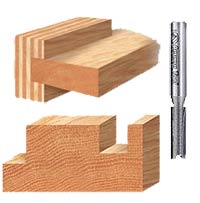
I assumed that since there is a special sized bit for a dado for plywood, all nominal plywood must be the same thickness. The plywood I purchased for one job came in three different sizes. Is this unusual, and what’s the solution?
Chris Marshall: Hardwood plywood can be as much as three sixty-fourths of an inch thinner than its nominal thickness and still meet industry tolerances. Its thickness is also influenced to some extent by changes in humidity. The way I deal with these variables is to cut my dadoes with a stacked dado set on the table saw whenever possible. I shim the blade to match the thickness of the actual divider or shelf I’m installing, and I make test cuts in scrap to check my setup — a pretty standard approach. When you’re using a router and undersized plywood bit, you may have no choice but to reset the guide fence and make another pass in order to widen the dado a hair.
Richard Jones: Generally I find the most satisfactory solution is to avoid the full housing (dado) and go for the tongue and housing. If you’re using, let’s say, three- quarter-inch plywood, rout a convenient router cutter diameter, say a half-inch groove or housing in the female part, then rout a matching shy half-inch tongue in the male part to suit the groove. If your boards vary in thickness a bit, rout the tongue a hair tight and get it to the final size with a pass or two of a shoulder plane.





